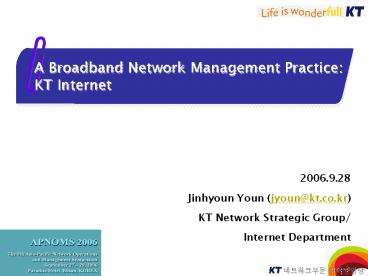A%20Broadband%20Network%20Management%20Practice:%20KT%20Internet - PowerPoint PPT Presentation
Title:
A%20Broadband%20Network%20Management%20Practice:%20KT%20Internet
Description:
Brief History of KT Internet Service and NMS. KT Internet Management Systems Experiences ... Internet Dept/Network Strategic Group. Brief History of KT Internet NMSs ... – PowerPoint PPT presentation
Number of Views:205
Avg rating:3.0/5.0
Title: A%20Broadband%20Network%20Management%20Practice:%20KT%20Internet
1
A Broadband Network Management Practice KT
Internet
- 2006.9.28
- Jinhyoun Youn (jyoun_at_kt.co.kr)
- KT Network Strategic Group/
- Internet Department
2
Contents
- Brief History of KT Internet Service and NMS
- KT Internet Management Systems Experiences
- NeOSS-IP Core NMS
- Performance Measurements
- Traffic Analysis
- Routing Information Management
- New Features for Premium Networks
- Future Directions
3
Brief History of KT Internet Service
4
Brief History of KT Internet NMSs
- At the initial stage(1996), primitive monitoring
and fault management functions based on the
production systems like Openview or CiscoWorks
were the main usage of Internet NMS - As the network grew, in-house software were much
more preferred and KOSMOS(Kornet Service
Managements and Operation Support systems,1996)
was the first integrated style Internet NMS for
KT. Simple monitoring functions were expanded to
reacheability and availability management - As the portion of the Internet (and data
networks) grew in the revenue, the
interoperability with other infrastructure
(espeially the main telco infrastructure) got
much more important, and NEOSS-IP was confronted
in 2002. Various Measurements and analysis were
added.
5
KT Internet Service and Mgmt
- NeOSS-IP and its sub systems
- CORE-NMS, Premium NMS, Multicast NMS,
- Access NMS
- Analysis Systems
6
NeOSS-IP and its Subsystems
- NeOSS-IP is an NMS system for IP networks in KT
NeOSS systems - NeOSS-IP includes subsystems for operation tools
like - Traffic, Performance, RIB analysis systems
- Configurations, Remote Operations support tools
7
Performance Measurements
- IPAS(Internet Performance Analysis System)
- As a start point of service level (quality)
managements - Like sorts of network weather systems
- UDP/TCP active measurements over thousands of
paths per minutes using probes (special-purposed
routers) - Focus on UDP and jitter delay and loss rather
than simple ICMP stuffs
8
Performance Measurements(2)
- What we can learn from IPAS
- General Packet Transmission or IP Service Quality
Levels over the backbone networks - Abrupt packet transmission delays due to events
on the backbone networks
9
Traffic Analysis
- Three ways of Traffic Understanding
- General traffic volume analysis using CORE-NMS
- Traffic flow analysis using routers and IP-FLOW
system - Traffic Packet Analysis using PACAS(Packet
Characteristics Analysis system)
10
Traffic Analysis (2)
- What we can learn from CORE-NMS
- The total traffic volumes over KT backbone,
overseas, IX networks - The link utilizations
- What we can learn from IP-FLOW
- The general trend of the traffic usage
- ex. per applications(ports), per ASN, per
POPs/Access services and so on
11
Traffic Analysis (3)
- What we can learn from PACAS
- The analysis results can be used directly for
engineering - Illegal packets with wrong IPs
- DDOS packets
- Out-of-Sequence/Order ratio and so on
- Packet Level Characteristics
- PDF of Packet Arrivals
- Traffic volumes at tiny time units(micorseconds
units) - Microscopic version of data which we can get from
IP-Flows i.e. per ports/IP Addrs/ASN traffic
distribution and so on
12
Routing Information Management
- IRIMS(IP Routing Information Managements System)
- Routes(Prefixes) changes archives
- Realtime change monitoring supported
- Routing Daemons and SNMP are used together
13
Routing Information Management(2)
- What we can learn from IRIMS
- Real time routing information change monitoring
- BGP Session and prefix changes monitoring
- ISIS links changes monitoring
- FLAPS and routing process overloads
- Inconsistent AS
14
New Features for Premium Networks
- MPLS managements
- New elements for MPLS LDP, LSP, LIB, MPLS IFs
and Tunnels - Dynamic LSP managements
- MPLS-TE Prototypes
- QoS Managements
- New elements for QoS(DIFF_SERV) Queues and
policies - DIFF_SERV management with backbone policy server
- Per class Traffic, Delay, Jitter, Loss
- Per Tunnel Traffic
- Multicast Managements
- New elements for Multicasts Multicast tunnels,
RPs, Ifs, - IGMP, PIM_SM, MSDP Management
15
Near Future Beyond Broadband
- Service Needs
- More bandwidths
- Various access technology
- Personalization
- Convergences in services
- BCN Service Concepts
- Broadband Convergence Network
- high-quality broadband multimedia services
Integrating telecom, broadcasting, and Internet
seamlessly at anywhere, anytime, and using any
devices - KEYWORDS QoS, IPv6, MPLS, IMS, Convergence
16
BCN at the moment
- BcN(backbone network-the premium network) has
been deploying since 2005 - DIFFSERV for the basic backbone CoS
- MPLS for the enhanced availability
- Packetized Voice, IP-TV, and Wibro on the
premium network - CoS applied for service classes
- BcN Service Infrastructure including various
control mechanisms will be implemented soon - IMS based service control systems Resources and
Services(Session) - Large-scale user(subscribers) handling features
17
NMS Expectations
AS IS
- BROADBAND and its components have been the main
NMS objects so far - Mainly networks, elements, and facilities are
main concerns for NMS
To Be
- Ubiquitous service and convergence might be
regarded as the next theme - End-to-end application/service supports will be
the next concerns
- The volumes, numbers, core-technologies of the
networks will be continuously increasing - The underlying network functions and the
services will be tightly coupled and the layering
conventions will be ambiguous
18
Concluding Remarks What we will do
- Even though the underlying technologies or
networks is expected to be more complex, the NMS
and its view for operators should be simpler
Integrated but selectable(and flexible) user
interfaces - On the shared platforms, the interoperability
between NMS systems for various networks/services
should be achieved. - To support convergence trends, the unified
platform for supporting customers will be more
important.











![Cranfield%20School%20of%20Management%20and%20The%20Principles%20for%20Responsible%20Management%20Education%20[PRME] PowerPoint PPT Presentation](https://s3.amazonaws.com/images.powershow.com/P1253037202WYrdF.th0.jpg?_=20180614034)



















